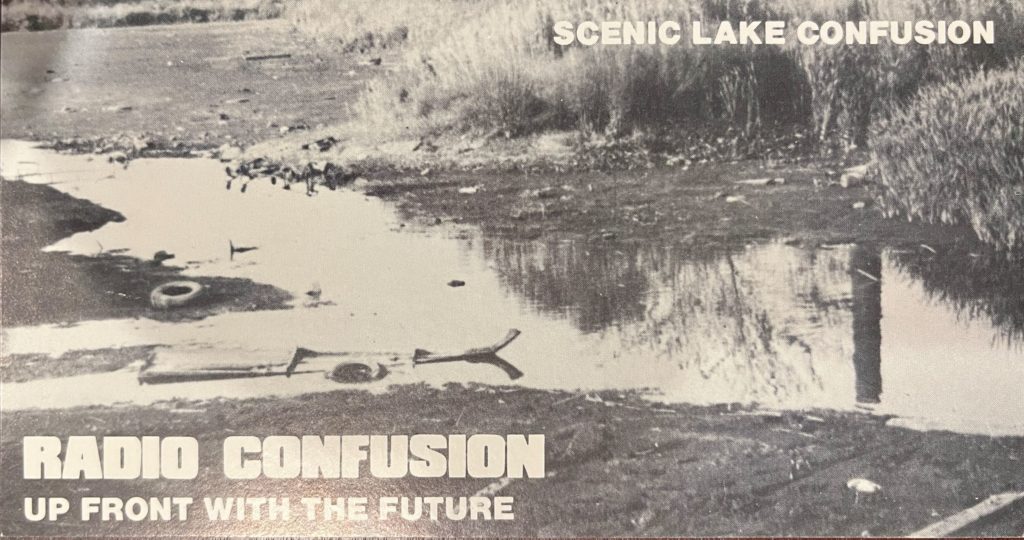And no, I’m not talking about the clandestine radio station that sent me this QSL card.

My confusion is over is the frequency range for FM radio in the United States. This should be an easy question, and the official answer is:
The FM broadcast in the United States starts at 88.0 MHz and ends at 108.0 MHz. The band is divided into 100 channels, each 200 kHz (0.2 MHz) wide. The center frequency is located at 1/2 the bandwidth of the FM Channel, or 100 kHz (0.1 MHz) up from the lower end of the channel.
— Federal Communications Commission
And further research indicates that there other frequency ranges in other parts of the world.
In Europe and Africa (defined as International Telecommunication Union (ITU) region 1) and in Australia and New Zealand,[1] it spans from 87.5 to 108 megahertz (MHz) – also known as VHF Band II – while in the Americas (ITU region 2) it ranges from 88 to 108 MHz. The FM broadcast band in Japan uses 76 to 95 MHz, and in Brazil, 76 to 108 MHz. The International Radio and Television Organisation (OIRT) band in Eastern Europe is from 65.9 to 74.0 MHz, although these countries now primarily use the 87.5 to 108 MHz band, as in the case of Russia. Some other countries have already discontinued the OIRT band and have changed to the 87.5 to 108 MHz band.
— Wikipedia
To simplify, US starts at 88 and Europe/Africa/Oceania starts at 87.5 MHz.
My confusion comes from dealing with real radios. Many portable radios with FM have a setting for the FM range, allowing the radio to function in a familiar way in different regions. On some of those radios, the FM setting also controls other things like the MW step (10 kHz in the Americas and 9 kHz most everywhere else) and sometimes the temperature scale, C or F.
Now here is where it gets weird. Let me quote from the Grundig G6 shortwave radio owner’s manual:
In North America, the FM band begins at 87.5 MHz. In other parts of the world, it may begin at 87 MHz or 76 MHz.
— Grundig G6 AVIATOR Owner’s Manual
One sees identical language in the Grundig G5 Owner’s Manual and in the Eton Elite Executive manual is something similar:
In North America, the FM band begins at 87.5MHz. In other parts of world, it may begin at 64MHz, 76MHz or 87MHz.
— Eton Elite Executive Owner’s Manual
The new Qodosen SR-286 was reportedly designed by the same person who designed the Eton Elite Executive. It’s manual says:
87-108MHz (suitable for Europe, Oceania, Africa, Asia)
87.5-108 MHz (suitable for China, Americas)
— Qodosen SR-286 User Guide
That’s mostly harmless until the selection of the FM frequency range affects other things, like with the new XHDATA D-608WB radio where the manual instructs the user to set the frequency to 87.5 in order to get the correct American MW step of 10 kHz and the Fahrenheit temperature scale.
— XHDATA D-608 User ManualWhen the FM receiving frequency is selected: 87.5-108 MHz:
- The corresponding MW frequency coverage is automatically set to: 520-1710 (10K) (applicable to North and South America.
- In this state, the temperature will be displayed in degrees Fahrenheit (°F)
Other radios get it mostly right. This is from the LiJiANI Rd239 manual (V3.0):

And this from the HanRongDa HRD-A320 instructions (similar to HRD-701 and Raddy RF75A):

In fact, the only radios that I could find with a setting that allows 88-108 are the Tecsun PL-330, PL-660 and PL-880. The PL-990 and PL-380 don’t have it.
Other radio manuals don’t take a position about what setting to use where.

And then there are the Franken-FMs: Low-power TV stations on channel 6 (RF) that are allowed *by the FCC*, **in 2024**, to use the old analog audio channel 6 carrier frequency – which happens to be 87.75 – for what is essentially an FM broadcast. With stereo and everything. There’s one in the Washington DC market. Obviously a radio that starts at 88.1 wouldn’t be able to tune those in. Of course most FM radios tune to 87.7, not 87.75, but the FCC wants 87.75 so 87.75 it is.
They have not closed down, by the way. The FCC’s final decision was to grandfather the ones that were already established before the analog shutdown. No new ones will be permitted. Observe: https://www.insideradio.com/free/fcc-approves-plan-to-allow-low-power-tv-stations-to-program-to-radio-listeners-at/article_7c2c1118-278f-11ee-a34c-97e25e2a9418.html
There also happens to be one lone translator that’s FCC authorized to be on 87.9. If you find yourself in Sun Valley, NV and feel the urge to jam to some Christian Satellite Network, that’s where you’ll find it, on K200AA.
So while technically the FM band in the USA starts at 88 MHz, there are officially sanctioned stations a bit below that.
I’ve never seen an FM radio of any brand or vintage (other’n the ones with the 1940s FM band of course) that *didn’t* have the ability to tune in 87.7 MHz. Probably because back in the stone age we actually could – and did – listen to Channel 6 audio on the suckers.
The US is in ITU Region 1, which allocates 87.5 to 108 MHz for “terrestrial broadcast”:
https://www.itu.int/en/ITU-R/terrestrial/broadcast/Pages/Bands.aspx
(see the VHF Bands table).
So under ITU rules, the FCC could decide to license FM from 87.5 to 88 MHz, but doesn’t currently. The audio part of analog TV channel 6 was at 87.75 MHz, so many FM receivers could receive it. There were a few Channel FrankenFM stations which were TV stations functioning essentially as radio stations, the last of which closed down not long ago.
The US is in ITU Region 2, not 1.
Indeed.